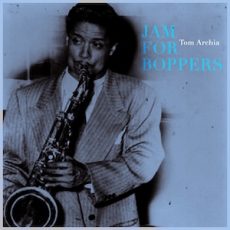
Daily Dose Of Jazz…
Theodor Christian Frølich Bergh, better known as Totti Bergh was born December 5, 1935 in Oslo, Norway. He began playing clarinet, and started learning to play the saxophone in 1952. By the time he turned 21 in 1956, he became a professional musician, becoming a regular member of Kjell Karlsen Sextet for three years, in addition to collaborating sporadically with Rowland Greenberg and other musicians on the Norwegian jazz scene.
He joined the Norwegian America Ships house orchestra on the voyage to New York City. In 1960 Totti succeeded Harald Bergersen as tenor saxophonist in Karlsen’s new big band and in the summer of 1961 he met his future wife Laila Dalseth, who joined the band.
He would go on to play with the bands of Einar Schanke, Rowland Greenberg, Per Borthen and in Dalseth’s orchestra. During the Nineties he played tenor and soprano saxophone with Christiania Jazzband and with Christiania 12.
Saxophonist Totti Bergh, who released several albums as a leader and whose music is reminiscent of Lester Young and Dexter Gordon, died January 4, 2012 in his home city.
More Posts: bandleader,history,instrumental,jazz,music,trombone

Daily Dose Of Jazz…
Nathan Gershman was born Nathan Gerschman on November 29, 1917 in Philadelphia, Pennsylvania. He received classical training at the Curtis Institute of Music, graduating in 1940 and from that point in his life he played with the Cleveland Orchestra.
In 1947 Nathan moved to New York City to work as a studio musician, then worked in the same capacity in Los Angeles, California after 1954. Three years later he replaced Fred Katz as cellist in Chico Hamilton’s band, playing and recording in his band until 1961. As a jazz musician, he worked with Nat Adderley, Gábor Szabó, and Ronnie Laws during the 1970s.
Gershman was frequently active as a session player and studio musician for television, theater, and recordings in and around Los Angeles from the Sixties into the 1990s. He recorded on albums by David Axelrod, The Beach Boys, Geronimo Black, David Bromberg, Neil Diamond, Lee Hazlewood, Wayne Henderson, Van Dyke Parks, Esther Phillips, and Pleasure.
Cellist and session musician Nathan Gershman, who played in popular music, jazz, and classical idioms, died on September 13, 2008 in the North Hollywood neighborhood of Los Angeles, California.
More Posts: cello,history,instrumental,jazz,music

Daily Dose Of Jazz…
Terry Plumeri was born John Terryl Plumeri on November 28, 1944 in Greensboro, North Carolina, and grew up in Tampa, Florida. He began studying music when he was 10 and while attending Chamberlain High School, he was introduced to the double bass by band director Robert Price. He went on to attend the Manhattan School of Music in New York City, studying with Robert Brennand, then the principal bassist in the New York Philharmonic. Later, he studied composition and conducting with Antal Doráti.
During his military service, Terry was a member of the Air Force Band. After his discharge he played with among others John Abercrombie, Cannonball Adderley, Herbie Hancock, Woody Herman, Quincy Jones, Yusef Lateef, Les McCann, Wayne Shorter, Frank Sinatra, Ralph Towner, and Joe Williams.
He performed, toured, and recorded with Roberta Flack from 1969 to 1974, playing electric and acoustic bass. He appears on the albums Chapter Two, Quiet Fire, Killing Me Softly, and wrote the song Conversation Love on the latter album.
Moving to Los Angeles, California to work in the film industry, Terry wrote the music for over 50 feature films, and his score for the film One False Move was nominated for Best Score by the IFC Independent Spirit Awards. In later years, he was guest conductor for the Moscow Philharmonic Orchestra and was a frequent guest lecturer, teacher, music producer, and photographer.
Double bassist, classical and film score composer, orchestra conductor, lecturer, teacher, and producer, and composer Terry Plumeri was murdered by burglars during a home invasion on March 31, 2016 in Dunnellon, Florida. He was 71.
More Posts: bandleader,bass,composer,conductor,history,instrumental,jazz,lecturer,music,producer,teacher

Daily Dose Of Jazz…
Tom Archia was born Ernest Alvin Archia, Jr. on November 26, 1919 in Groveton, Texas, and moved with his family as a child to Rockdale and then Baytown, near Houston, Texas. He played saxophone in the Wheatley High School orchestra. Known during childhood as Sonny, but took the name Tom when he decided that neither his first or middle names were appropriate for a musician.
After graduating from Prairie View A&M University in 1939, he joined Milt Larkin’s band which included Eddie Vinson, Arnett Cobb, and Illinois Jacquet in the reed section and Cedric Haywood as pianist and arranger. 1942 saw Archia arrived in Chicago, Illinois with Larkin for a nine-month residency backing T-Bone Walker at the Rhumboogie Club.
The following year he joined the Roy Eldridge orchestra alongside Ike Quebec, Ted Sturgis, and Doc West that recorded in Chicago for the Brunswick label. He moved to the Rhumboogie Dream Band until mid 1944. Unfortunately he frequently disrupted band discipline and was fired by Marl Young who took over as bandleader.
In 1945 Tom went to Los Angeles, California and joined Howard McGhee’s combo, with Teddy Edwards, among others. Shortly afterwards, he was recording with the brothers Illinois and Russell Jacquet, as well as Helen Humes.
Returning to Chicago in 1946, Archia became a headliner at the Macomba Lounge, recorded extensively for Aristocrat Records during the late Forties, and recorded with Wynonie Harris and Hot Lips Page. He would go on to participate in tenor saxophone duels with Buster Bennett, Gene Ammons, Claude McLin, Hal Singer, Harold Ashby, Porter Kilbert and Lucius Washington.
By the Sixties he was struggling to find gigs and he retired to Houston in 1967, after being temporarily disabled by a broken jaw. After recovering, he played the Houston club circuit for the rest of his life. Tenor saxophonist Tom Archia died on January 16, 1977 at the age of 57.
More Posts: history,instrumental,jazz,music,saxophone



